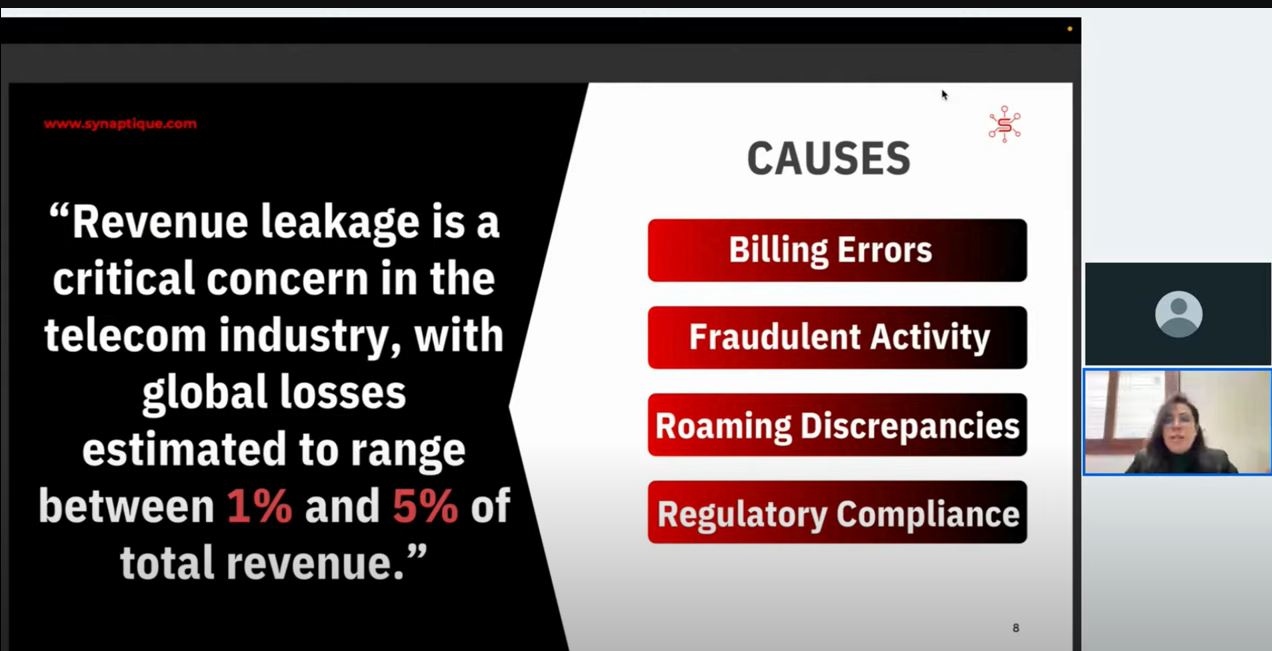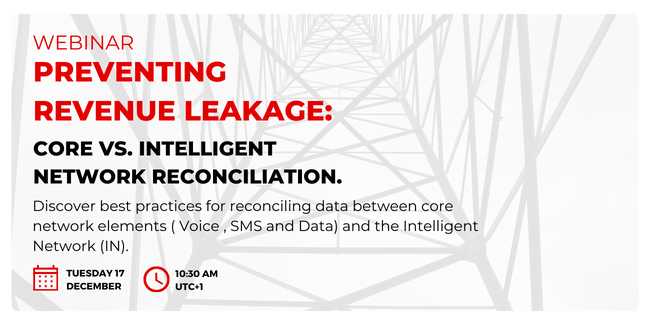Telecom operators face constant challenges in ensuring accurate reconciliation between core and intelligent network elements for preventing revenue leakage and ensuring seamless service delivery. During our recent webinar, Preventing Revenue Leakage: Core vs. Intelligent Network Reconciliation, we explored:
- The importance of reconciling data between core network elements (MSC, SMS-C, GGSN, SGSN) for revenue assurance.
- Common challenges encountered in Voice, SMS, and Data reconciliation.
- Practical demonstrations on reconciling data effectively between core network elements and the Intelligent Network (IN) to prevent revenue leakage and ensure data accuracy.

We also engaged in a vibrant Q&A session, addressing critical questions from participants. Here’s a recap of the key questions and our expert responses:
1. Why Don’t Postpaid Accounts Show on OCS in MSC vs OCS Reconciliation?
Answer: There are two scenarios:
- OCS manages both prepaid and postpaid accounts: In this case, OCS generates Call Detail Records (CDRs) for all accounts (prepaid, hybrid, postpaid), and these CDRs are reconciled with MSC data.
- OCS manages only prepaid and hybrid accounts: In this scenario, OCS doesn’t generate CDRs for postpaid accounts. Instead, another system (Offline Billing) collects postpaid CDRs directly from MSC for rating. The reconciliation process must include these rated records from Offline Billing to complete the reconciliation.
2. How to Handle Pay-As-You-Go (PAYG) and Bundles for Prepaid Accounts?
Answer: Prepaid subscribers their voice, SMS, and data usage can be charged as follows:
- PAYG (Pay-As-You-Go) charges are deducted from the main account for airtime.
- Free resources purchased via main account airtime or mobile money wallet.
For both scenarios the reconciliation process traces the sms, voice and data usages in both MSC and OCS. However, reconciling free resource usage vs. bundle purchased at the OCS level accuracy depends on how operators manage balances:
- If operators use separate balances for each bundle, the reconciliation process is straightforward and can verify the accuracy of the consumption of the bundle.
- If operators accumulate free resources from different bundles into a single balance, reconciliation becomes more complex.
3. How Do You Manage Different Operator File Structures in CDR Analysis Tools (e.g., Ericsson vs Huawei)?
Answer: The reconciliation process is designed to be scalable and vendor-agnostic. All vendor CDRs are mapped into a unified schema, ensuring compatibility and streamlined analysis across different systems.
4. How Can VoLTE Reconciliation Be Effectively Done?
Answer: VoLTE reconciliation involves challenges related to both voice and data portions of traffic. While a deep dive into this topic is planned for a dedicated webinar, initial considerations include correlating VoLTE data and voice records across network elements and billing systems.
5.Est-il possible d’identifier les numéros qui peuvent émettre des appels mais pas identifiés sur IN (ENG:Is It Possible to Identify Numbers That Can Make Calls but Are Not Registered on the IN?
Answer: Yes, it is possible. The reconciliation process must access Know Your Customer (KYC) data from CRM to enrich CDRs from both MSC and OCS. This enables filtering for non-identified subscribers engaging in traffic (voice, SMS, or data).
6. Comment détecter des numéros créés sur HLR et non sur IN (ENG:How Can We Detect Numbers Created on HLR but Not on IN?)
Answer: This can be achieved by reconciling dumps from HLR and OCS. By comparing these datasets, it’s possible to identify MSISDNs enabled on the HLR but not on the OCS.
7.Please can you guide us on how to effectively reconcile PGW vs OCS
Answer: The PGW usually generates a lot of intermediate CDRs with a unique correlation ID called the Charging ID, which is also reported in data charging CDRs from OCS. Effective reconciliation involves:
- Aggregating CDRs from PGW.
- Joining aggregated data with OCS records using MSISDN and Charging ID.
Key Takeaways from the Webinar
- Data reconciliation is essential for ensuring revenue assurance and preventing revenue leakage.
- Challenges vary across network elements, but scalable, vendor-agnostic solutions simplify the process.
- Accurate reconciliation requires enriching datasets with external information like KYC data.
- Collaboration between network teams and revenue assurance specialists is crucial for success.
Access the Webinar Recording
Missed the webinar or want to revisit specific sections? Watch the full recording for detailed insights and practical demonstrations:
📺 Watch the Webinar Recording Now
If you have further questions or need personalized support for your reconciliation challenges, don’t hesitate to reach out to our team. Let’s work together to safeguard your revenue and optimize your operations!
